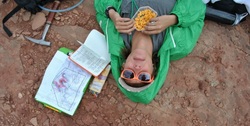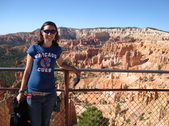The EDGElab attic....
Archived News Items...
Undergraduate student Mariah Morales is a recipient of a 2022 UIC LAS Undergraduate Research Initiative (LASURI) grant! She's planning to investigate microplastics in natural soil ecosystems! las.uic.edu/lasresearch/student-research/lasuri/
Graduate student Sarah Khoury was awarded a research grant from the Nature Conservancy to investigate whether microplastics are present in soils at the Nachusa Grasslands! She's separating microplastics from soils and using microcosms to investigate the impact of microplastics on these soil ecosystems. www.nachusagrasslands.org/
Graduate student Judy Malas and undergraduate Moriah Morales have received research grants/fellowships from the Illinois Space Grant Consortium! Judy is investigating morphological changes induced by high pressure in the model organisms Shewanella oneidensis and Staphylococcus warneri, and Mariah studies microplastics in soil ecosystems.
Graduate student K. Woycheese is a recipient of a 2015 NASA Astrobiology Postdoctoral Fellowship! She's off to MIT to work with Dr. Shuhei Ono and the Univ. of CO, Boulder NAI team. CONGRATS!
April, 2014 - Caitlin Casar has received the Provost’s Award from the Graduate College for her project “Biological Influence on Mineralogical Evolution of the Zambales Ophiolite, Philippines!” Well done, Caitlin!
Kristin Woycheese's work has been featured on the AGU Blogosphere following her presentation at the 2012 AGU conference. Click HERE to read all about it!
Graduate student Sarah Khoury was awarded a research grant from the Nature Conservancy to investigate whether microplastics are present in soils at the Nachusa Grasslands! She's separating microplastics from soils and using microcosms to investigate the impact of microplastics on these soil ecosystems. www.nachusagrasslands.org/
Graduate student Judy Malas and undergraduate Moriah Morales have received research grants/fellowships from the Illinois Space Grant Consortium! Judy is investigating morphological changes induced by high pressure in the model organisms Shewanella oneidensis and Staphylococcus warneri, and Mariah studies microplastics in soil ecosystems.
Graduate student K. Woycheese is a recipient of a 2015 NASA Astrobiology Postdoctoral Fellowship! She's off to MIT to work with Dr. Shuhei Ono and the Univ. of CO, Boulder NAI team. CONGRATS!
April, 2014 - Caitlin Casar has received the Provost’s Award from the Graduate College for her project “Biological Influence on Mineralogical Evolution of the Zambales Ophiolite, Philippines!” Well done, Caitlin!
Kristin Woycheese's work has been featured on the AGU Blogosphere following her presentation at the 2012 AGU conference. Click HERE to read all about it!
Archived Graduate Student Profiles...

Michael Tanzillo, M.S., 2023
Michael joined the lab as a M.S. student after completing his undergraduate degree at UIC, and helping EDGElab launch its investigations into landfill soil microbiomes. His M.S. research focuses on investigations of microbial communities present in 'elevated temperature landfill' soil compared to 'normal' temperature landfill soils. Elevated temperature landfills are those that, for unknown reasons, build internal temperatures that can exceed 80C. Normal landfill temperatures are ~40-50C. Elevated temperature landfills can become hot enough that landfill leachate can erupt much like a geyser! Michael is investigating profiles of microbial communities through amplicon sequencing of the 16S rRNA gene, to see how those in elevated temperatures compare to those of normal temperatures. This will be a first step in understanding the impact of high temperatures on normal landfill function and greenhouse gas emissions.
Michael joined the lab as a M.S. student after completing his undergraduate degree at UIC, and helping EDGElab launch its investigations into landfill soil microbiomes. His M.S. research focuses on investigations of microbial communities present in 'elevated temperature landfill' soil compared to 'normal' temperature landfill soils. Elevated temperature landfills are those that, for unknown reasons, build internal temperatures that can exceed 80C. Normal landfill temperatures are ~40-50C. Elevated temperature landfills can become hot enough that landfill leachate can erupt much like a geyser! Michael is investigating profiles of microbial communities through amplicon sequencing of the 16S rRNA gene, to see how those in elevated temperatures compare to those of normal temperatures. This will be a first step in understanding the impact of high temperatures on normal landfill function and greenhouse gas emissions.
Bharathi Vallalar - grad. 2017

Ph. D.
I am culturing microbes from fluid and sediment samples collected from highly alkaline (pH 11-12) springs from deep-biosphere ecosystems. We will then investigate the metabolic strategies employed by these organisms to survive in these high pH, low nutrient habitats. Understanding the organisms that live in these environments gives valuable insight into questions concerning the origin of life and has implications in astrobiological research. This work is part of a project funded by the National Science Foundation (EAR-1147334). My recent work has focused on the isolation of organisms living in extreme pH conditions, and their ability to cope with, or metabolize, Cu, Cr, Cd, Ni, and Zn. I'm also interested in the capacity of these organisms to break down cellulose.
M.S thesis - Vallalar, U., 2012. Investigation of the Growth and Survival of Bacteria from Mars Analog Environments When Exposed to Mars-Like Conditions, Louisiana State University, Baton Rouge.
I am culturing microbes from fluid and sediment samples collected from highly alkaline (pH 11-12) springs from deep-biosphere ecosystems. We will then investigate the metabolic strategies employed by these organisms to survive in these high pH, low nutrient habitats. Understanding the organisms that live in these environments gives valuable insight into questions concerning the origin of life and has implications in astrobiological research. This work is part of a project funded by the National Science Foundation (EAR-1147334). My recent work has focused on the isolation of organisms living in extreme pH conditions, and their ability to cope with, or metabolize, Cu, Cr, Cd, Ni, and Zn. I'm also interested in the capacity of these organisms to break down cellulose.
M.S thesis - Vallalar, U., 2012. Investigation of the Growth and Survival of Bacteria from Mars Analog Environments When Exposed to Mars-Like Conditions, Louisiana State University, Baton Rouge.
Kristin M. Woycheese - grad. 2015

Ph.D.
NASA NAI Postdoctoral Fellow at the Massachusetts Institute of Technology
Thesis: Geobiology of microbial ecosystems in terrestrial serpentinizing environments
Kristin investigated ecosystems in fluids produced by the process of "serpentinization." The organisms in these systems are able to make a living off of the products of serpentinization: mainly hydrogen and methane gas. She asked questions about the similarities and differences between serpentinizing fluid communities that live isolated from the surface, and those that are exposed to surface conditions (light and oxygen, for example). For example, how much genetic material do deep subsurface communities provide to surface communities? Do these systems preserve a "genetic legacy" of the deep subsurface stored in surface ecosystems? How do deep subsurface organisms adapt after being exposed to surface conditions? This project was funded by a C-DEBI Graduate Fellowship.
Kristin was also interested in lacustrine microbialites. The experimental approach was to determine how much CO2 could be sequestered during the biomineralization of lacustrine microbialites. This project was funded by a IESP Fellowship from UIC. Kristin also had funding from the Illinois Space Grant Consortium to collect samples of microbialites from lakes of varying chemistry, to investigate how different lake chemistries affect microbialite formation and eventual preservation in the rock record.
December 2012: Kristin Woycheese's work has been highlighted on the AGU Blogosphere following the 2012 AGU meeting! Look here to read all about it!
Caitlin Casar - grad. 2015

M.S.
Ph.D. Dept of Earth and Planetary Sciences at Northwestern University
caitlincasar.weebly.com/
Thesis: Geobiology of the Zambales Ophiolite, Philippines and Coast Range Ophiolite, California
Caitlin used various culturing techniques to study the metabolisms of organisms in serpentine springs in the Philippines and Coast Range (US). Serpentine springs are considered extreme environments due to their alkaline nature as a result of chemical reactions with ultramafic rocks. Serpentine springs and soils are toxic to many organisms, and the ones that survive in them must be well-adapted. These types of environments may be where life originated on Earth and could be analogues for environments that potentially support life on other planets.
To investigate these systems, Caitlin focussed on interactions between the unique minerals found in serpentinizing systems and the microorganisms that live in the springs. The potential for organisms originating from serpentinizing systems to cycle iron was of particular interest, and Caitlin was able to culture organisms that reduce iron under high pH [~10] conditions. Her work supports predictions made by geochemical evaluations that iron cycling is a potential source of energy in these subsurface ecosystems.
Ph.D. Dept of Earth and Planetary Sciences at Northwestern University
caitlincasar.weebly.com/
Thesis: Geobiology of the Zambales Ophiolite, Philippines and Coast Range Ophiolite, California
Caitlin used various culturing techniques to study the metabolisms of organisms in serpentine springs in the Philippines and Coast Range (US). Serpentine springs are considered extreme environments due to their alkaline nature as a result of chemical reactions with ultramafic rocks. Serpentine springs and soils are toxic to many organisms, and the ones that survive in them must be well-adapted. These types of environments may be where life originated on Earth and could be analogues for environments that potentially support life on other planets.
To investigate these systems, Caitlin focussed on interactions between the unique minerals found in serpentinizing systems and the microorganisms that live in the springs. The potential for organisms originating from serpentinizing systems to cycle iron was of particular interest, and Caitlin was able to culture organisms that reduce iron under high pH [~10] conditions. Her work supports predictions made by geochemical evaluations that iron cycling is a potential source of energy in these subsurface ecosystems.
Katie Walther - grad. 2013

M.S.
Now a Physical Scientist at the EPA
Thesis: Ecology of Alkaline Hot Springs: Measuring Diversity and Structure of Chemosynthetic Communities
To date, many studies of microbial diversity have been conducted in hot spring ecosystems, like Yellowstone National Park. Many focus on the amplification of the 16S rRNA gene and “metagenomic” datasets. Other studies have focused on “gene hunting” and investigating the metabolic processes of the microorganisms present within the hot springs. However, few reports have focused on diversity at small scales, particularly within chemosynthetic zones. The focus Katie's research was to conduct a small scale biodiversity study of “Bat Pool”, an alkaline hot spring in Yellowstone National Park, using a 30 x 50 cm sampling grid with sixty 5 x 5 cm squares to sample both sediment and biofilm communities, and to compare this biodiversity with that of the surrounding outflow channel and with other similar areas within the park. This work will help us understand variation in microbial diversity over small spatial scales in geochemically diverse environments.
Now a Physical Scientist at the EPA
Thesis: Ecology of Alkaline Hot Springs: Measuring Diversity and Structure of Chemosynthetic Communities
To date, many studies of microbial diversity have been conducted in hot spring ecosystems, like Yellowstone National Park. Many focus on the amplification of the 16S rRNA gene and “metagenomic” datasets. Other studies have focused on “gene hunting” and investigating the metabolic processes of the microorganisms present within the hot springs. However, few reports have focused on diversity at small scales, particularly within chemosynthetic zones. The focus Katie's research was to conduct a small scale biodiversity study of “Bat Pool”, an alkaline hot spring in Yellowstone National Park, using a 30 x 50 cm sampling grid with sixty 5 x 5 cm squares to sample both sediment and biofilm communities, and to compare this biodiversity with that of the surrounding outflow channel and with other similar areas within the park. This work will help us understand variation in microbial diversity over small spatial scales in geochemically diverse environments.
